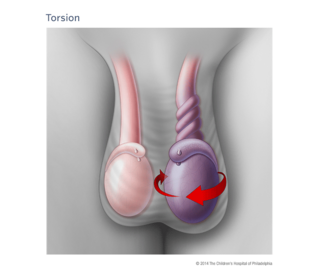What is testicular torsion?
Testicular torsion occurs when the testicle twists around the cord (the structure extending from the groin to the testes that contains the sperm ducts and blood vessels), like an apple twisting on its stem. When the blood vessels are twisted, they can cut off circulation to the testicle and cause permanent damage, including death of the testicle in as little as four hours.

Testicular torsion causes severe testicular pain and usually occurs in boys 10 years and older. While it generally occurs in adolescent boys, it may also occur during fetal development or shortly after a baby is born.
Causes
In pre-adolescent and adolescent boys, torsion occurs primarily from incomplete attachment of the testes within the scrotum. This permits the testes to be more movable, allowing them to twist. Testicular torsion in the fetus results when the protective sac that surrounds the testicles within the scrotum does not attach to the scrotum internally.
Signs and symptoms
Take your child to the emergency department immediately if he experiences any of the following symptoms:
- Scrotal pain that develops suddenly
- Increasing scrotal pain despite treatment with pain medication
- Redness and swelling of the scrotum
- Scrotal pain with abdominal pain, nausea or vomiting
- High-lying testicle
- Bruising or firmness of the scrotum in newborns
Testing and diagnosis
Testicular torsion is diagnosed when a physician examines your child or with a scrotal ultrasound. During the scrotal ultrasound we look for blood flow to the testicle.
Treatment
If your child has testicular torsion, the team in our Division of Urology will perform an operation to untwist the testicle and tack it down into the scrotum so it does not twist again. This will also be done to the opposite testicle.
Sometimes the testicle has been twisted for so long that it is dead and will need to be removed. The sooner your child is taken to the emergency department after the pain begins, the less likely the testicle will need to be removed.
Reviewed by: Division of Urology
Date: May 2011
Resources to help
Division of Urology Resources
Caring for a child with an illness or injury can be overwhelming. We have resources to help you find answers to your questions and feel confident in the care you are providing your child.
